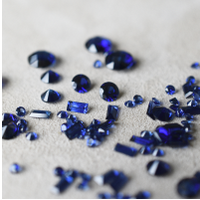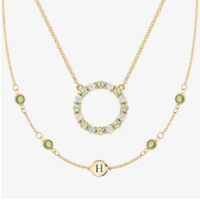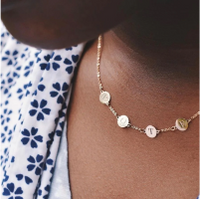Free Ground Shipping on orders $150+
Free 2-Day Air on orders $495+
Free Ground Shipping on orders $150+ | Free 2-Day Air on orders $495+
Popular Search Terms
Sorry, nothing found for ""
- EUR
- USD
- AUD $
- CAD
- GBP

- HAVERHILL
- GEMSTONES
Emerald’s meaning, styling, and care
Prized for its stunning deep-green hue since the time of the ancient Egyptians, the stunning Emerald, May's birthstone, symbolizes new beginnings, abundance, prosperity, friendship, growth, and fidelity in love. Learn how to style and care for this beautiful gemstone.
The meaning of Emerald
The gorgeous green Emerald, gemstone of the goddess Venus, has long been revered as a life- and love-affirming stone. Ancient peoples believed that the stone bestowed the gift of eloquence upon its wearers, as well as enabling them to predict the future and reveal the truth or falseness of a lover's words. It was also believed to enhance memory and eyesight.
Emerald is associated with the heart chakra, the body's emotional center, and is said to help open the heart to give and receive unconditional love. Stonecutters traditionally kept a piece of Emerald to gaze at to relieve eyestrain while working, as its soothing color was considered especially restful. Today, this beautiful birthstone represents health, wealth, abundance, and growth. Emerald is the gemstone for the 20th, 35th, and 55th anniversaries.

Emeralds have long been associated with spring and new beginnings. Wear Emerald to attract abundance, promote balance and harmony in your life, and keep your heart open to love in all its forms. Wearing a piece of Emerald jewelry is a lovely way to support and celebrate your personal growth. It's the birthstone for May and for the zodiac signs Taurus and Gemini.
A symbol of fertility (as the stone of Venus), fidelity, and friendship, Emeralds were once thought to protect against unfaithfulness by turning dull and losing their color and luster in the presence of someone who was disloyal. They were also considered a protection against poison and a defense against demons. The philosopher Aristotle encouraged parents to hang the gem around their children's necks to prevent epilepsy.

A symbol of fertility (as the stone of Venus), fidelity, and friendship, Emeralds were once thought to protect against unfaithfulness by turning dull and losing their color and luster in the presence of someone who was disloyal. They were also considered a protection against poison and a defense against demons. The philosopher Aristotle encouraged parents to hang the gem around their children's necks to prevent epilepsy.
Emerald – gemstone knowledge
The name Emerald comes from the Greek word smaragdus, meaning "green gem." (Makes sense!) Emerald is part of the Beryl family of minerals, which includes Aquamarine as well. Its beautiful green color comes from trace amounts of the elements chromium or vanadium. It ranges in hue from pale to deep green.
An extremely rare variety of the stone is called a "cat's eye" Emerald. It exhibits one or more long, narrow rays of white light on a cabochon-cut (polished) surface. This effect is known as chatoyancy.

An extremely rare variety of the stone is called a "cat's eye" Emerald. It exhibits one or more long, narrow rays of white light on a cabochon-cut (polished) surface. This effect is known as chatoyancy.
Emeralds have long been associated with spring and new beginnings.
Where is Emerald found?
The earliest known Emerald mines date back to ancient Egypt, and the stone was known to be a favorite of the Egyptian queen Cleopatra. Today, about 50 percent of all mined Emeralds come from Colombia, though the stone is also produced in other countries, including Australia, Brazil, Namibia, Zambia, and the United States.

HAVERHILL Emeralds are sustainably grown in a lab, which mimics their formation in nature. They share all the chemical, physical, and optical properties of naturally mined Emeralds, with outstanding color and excellent durability. We love sustainably grown gems because they're gentle on the earth and are beautifully consistent in their verdant radiance.

HAVERHILL Emeralds are sustainably grown in a lab, which mimics their formation in nature. They share all the chemical, physical, and optical properties of naturally mined Emeralds, with outstanding color and excellent durability. We love sustainably grown gems because they're gentle on the earth and are beautifully consistent in their verdant radiance.
Fun facts about Emerald
• The ancient Romans believed that lighter green Emeralds were "unripe," and that the gems would darken in color as they matured.
• While many gems come in various colors, Emeralds come in no other color but green.
• The world's largest uncut gem-grade Emerald, discovered in Zambia in 2021, weighed over three pounds (7,525 carats). It was named the Chipembele, after the indigenous word for "rhino" (the top of the crystal resembled a rhino's horn).
• The Chalk Emerald is famed as a near-perfect specimen of the gem. Weighing 37.8 carats, the step-cut stone displays a superb, saturated green color. It's set in a gold-and-platinum ring, surrounded by 60 pear-shaped Diamonds.
• Queen Victoria's Emerald and Diamond Tiara, designed by her husband, Prince Albert, features 19 inverted, pear-shaped Emeralds ranging in size from 1.75 to 15 carats. It's part of a parure that includes a matching 20-carat brooch.
• The famed Mogul Moghul Emerald is carved with Islamic prayers on one side and a floral motif on the other. It was sold in 2001 for $2.2 million, and today is on display at the Museum of Islamic Art in Qatar.
• An "Emerald cut" gem is rectangular, with long, parallel step facets (planes) that create a mirrored affect. A very popular cut for both Emeralds and Diamonds.

Caring for your Emerald jewelry
Emerald is a hard stone, rating 7.5-8 on the Mohs hardness scale. In 1822 Friedrich Mohs created this scale to rate gemstones from 1 (softest) to 10 (exceptionally hard), based on their ability to withstand scratches.
Your jewelry for everyday wear needs minimal care. You can wear it in the shower, while swimming, sleeping, and exercising. Follow these common-sense tips for keeping your jewelry in good repair:
• Store jewelry in its pouch or box to keep the gems from getting scratched by other stones.
• Remove rings before lifting weights or other heavy objects, which could cause the stone(s) to get scratched, or even bend the band itself.
• Avoid prolonged exposure to chlorinated water (an occasional dip is fine).

Your jewelry for everyday wear needs minimal care. You can wear it in the shower, while swimming, sleeping, and exercising. Follow these common-sense tips for keeping your jewelry in good repair:
• Store jewelry in its pouch or box to keep the gems from getting scratched by other stones.
• Remove rings before lifting weights or other heavy objects, which could cause the stone(s) to get scratched, or even bend the band itself.
• Avoid prolonged exposure to chlorinated water (an occasional dip is fine).
Maintain the beauty of your jewelry by keeping it clean. Use a non-abrasive jewelry cleaner or mild, dye-free dish soap and water. Let the jewelry soak in a small bowl for a few minutes, then brush gently with a soft toothbrush. Be sure to rinse it completely, and blot dry with a chamois cloth.

Maintain the beauty of your jewelry by keeping it clean. Use a non-abrasive jewelry cleaner or mild, dye-free dish soap and water. Let the jewelry soak in a small bowl for a few minutes, then brush gently with a soft toothbrush. Be sure to rinse it completely, and blot dry with a chamois cloth.
Styling tips for Emeralds
While Emerald looks stunning on its own, of course, it's surprisingly versatile when paired with other gems. Just as the green of flower stems and leaves acts as a natural complement to the riotous colors of their blooms, the verdant Emerald highlights the color of any gemstone it's paired with.
Diamond, of course, makes a perfect companion for Emerald. The brilliant white and deep green make each other pop! Emerald plays nicely with shades of pink and blue, too. Try pairing the gem with Pink Tourmaline or Nantucket Blue Topaz for a delicately floral color story.
In HAVERHILL's Terra Collection, Emeralds sit side-by-side with deep blue Sapphires to represent land and sea. Ten percent of the purchase price of Terra jewelry is donated to The Nature Conservancy, a global environmental nonprofit working to create a world where people and nature can thrive.

In HAVERHILL's Terra Collection, Emeralds sit side-by-side with deep blue Sapphires to represent land and sea. Ten percent of the purchase price of Terra jewelry is donated to The Nature Conservancy, a global environmental nonprofit working to create a world where people and nature can thrive.
Join our circle
FAQ
Tradition says that wearing your birthstone is good luck, so if you're a May baby, it's a great choice for jewelry! Emeralds are considered to be a lucky stone in general, so they make a wonderful gem for everybody. Try pairing it with Diamond or White Topaz to highlight its color, or lean into the green by wearing the gem on its own.
People wear gemstones for many reasons, not just because it’s the birthstone for the month they were born. You may choose to wear a stone because you feel a connection to the color, because its traditional meaning resonates with you, or because it reminds you of someone you love, such as a child, friend, or loved one who’s passed away. Jewelry is extremely personal and you should feel free to wear any gemstone that speaks to you.
Sustainably grown precious gems are genuine gemstones grown in a lab from a “seed” and are chemically, physically, and optically identical to naturally mined stones. These lab-grown gemstones have beautiful, consistent color and fewer inclusions than naturally mined stones. They're rated the same hardness on the Mohs scale.
Yes – you can wear it while showering, swimming, and exercising.
According to legend, Emerald can help heal the eyes, heart, and skin. It was once believed to strengthen the memory and promote fertility, as well.






























































































